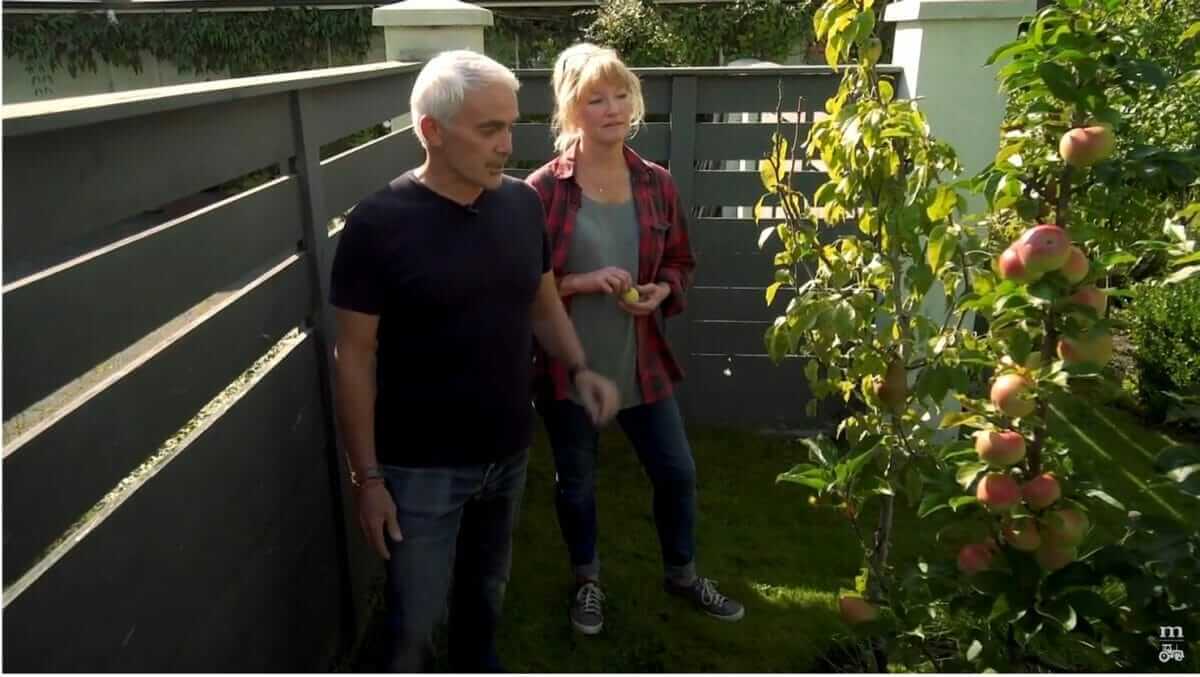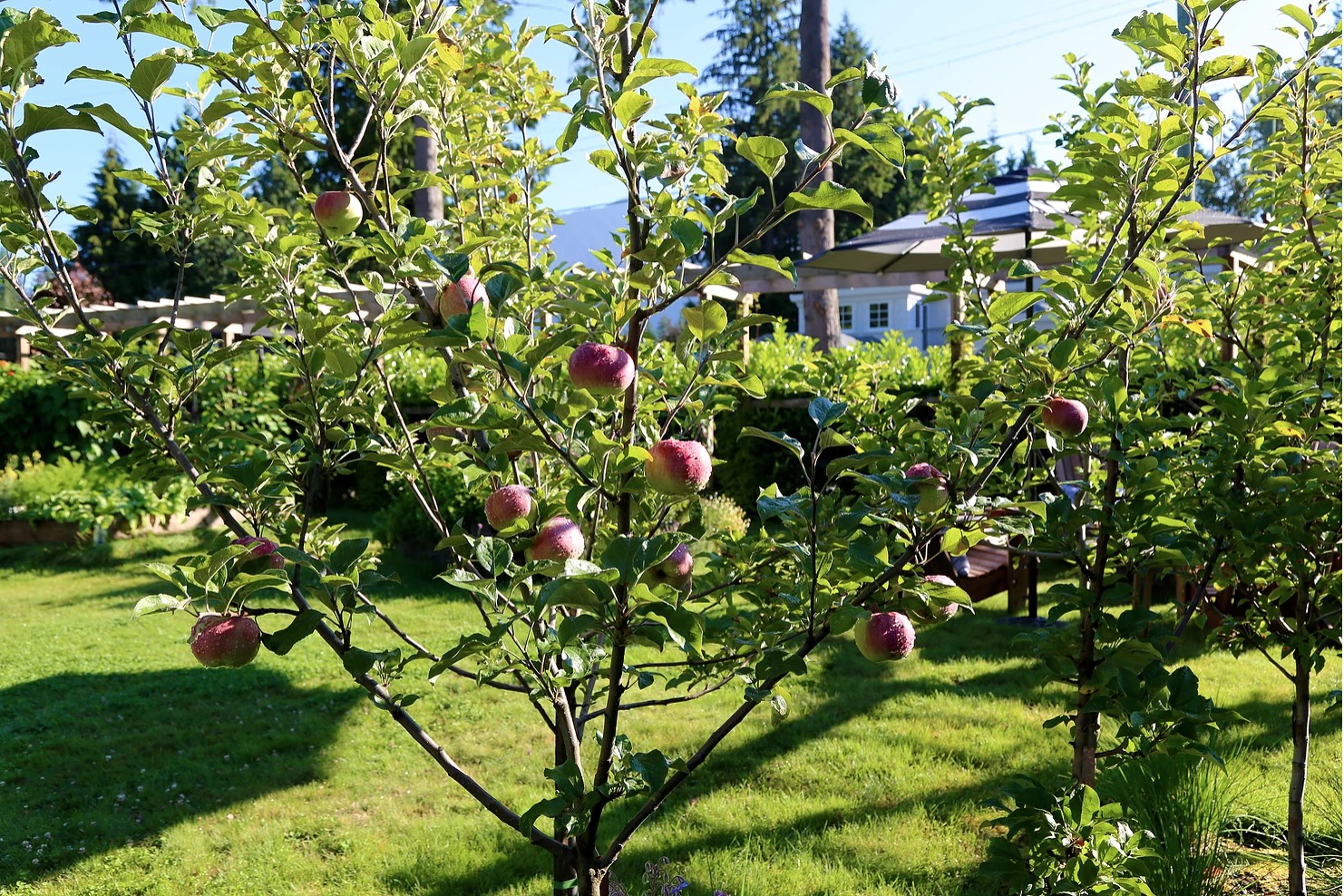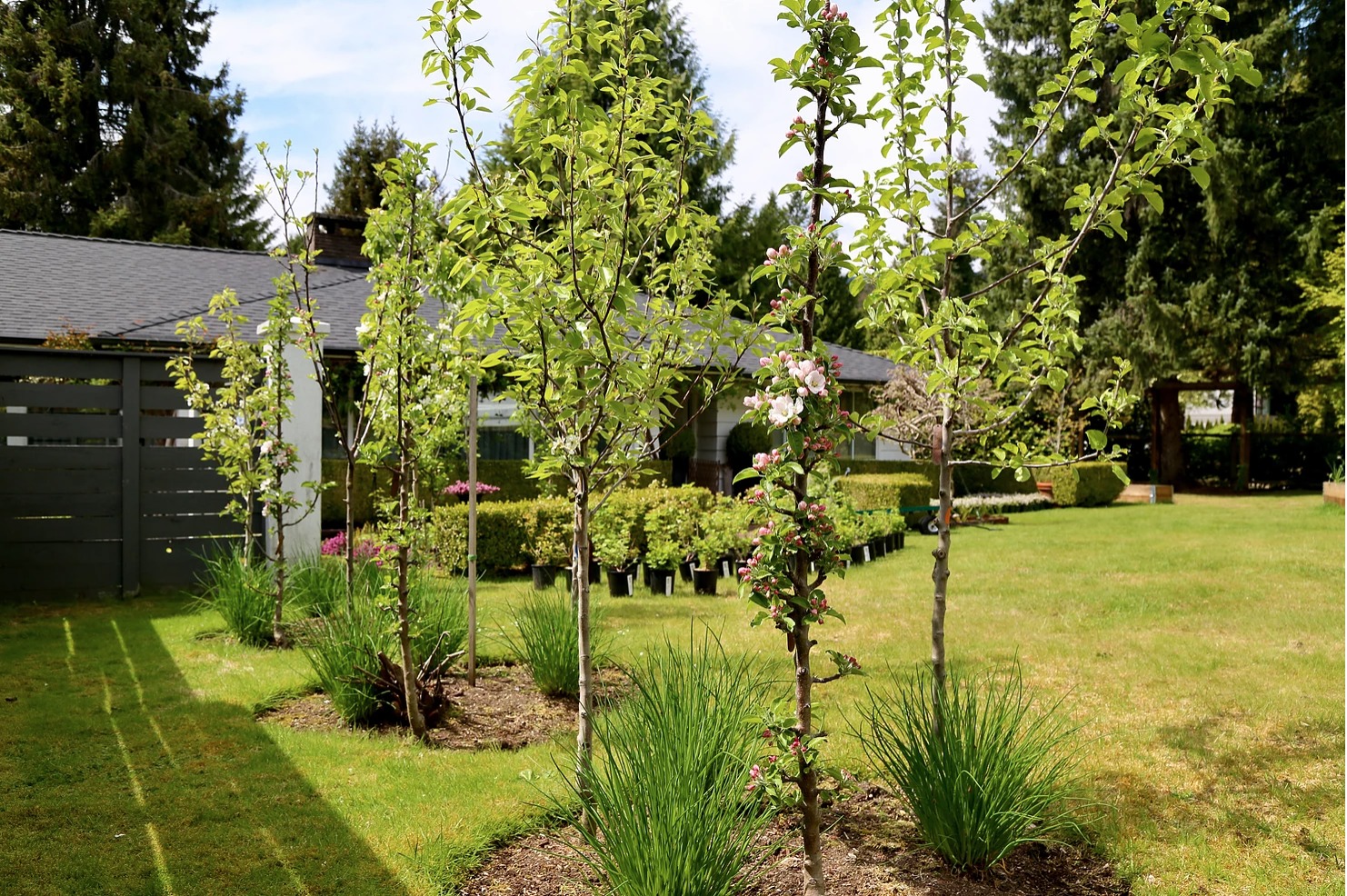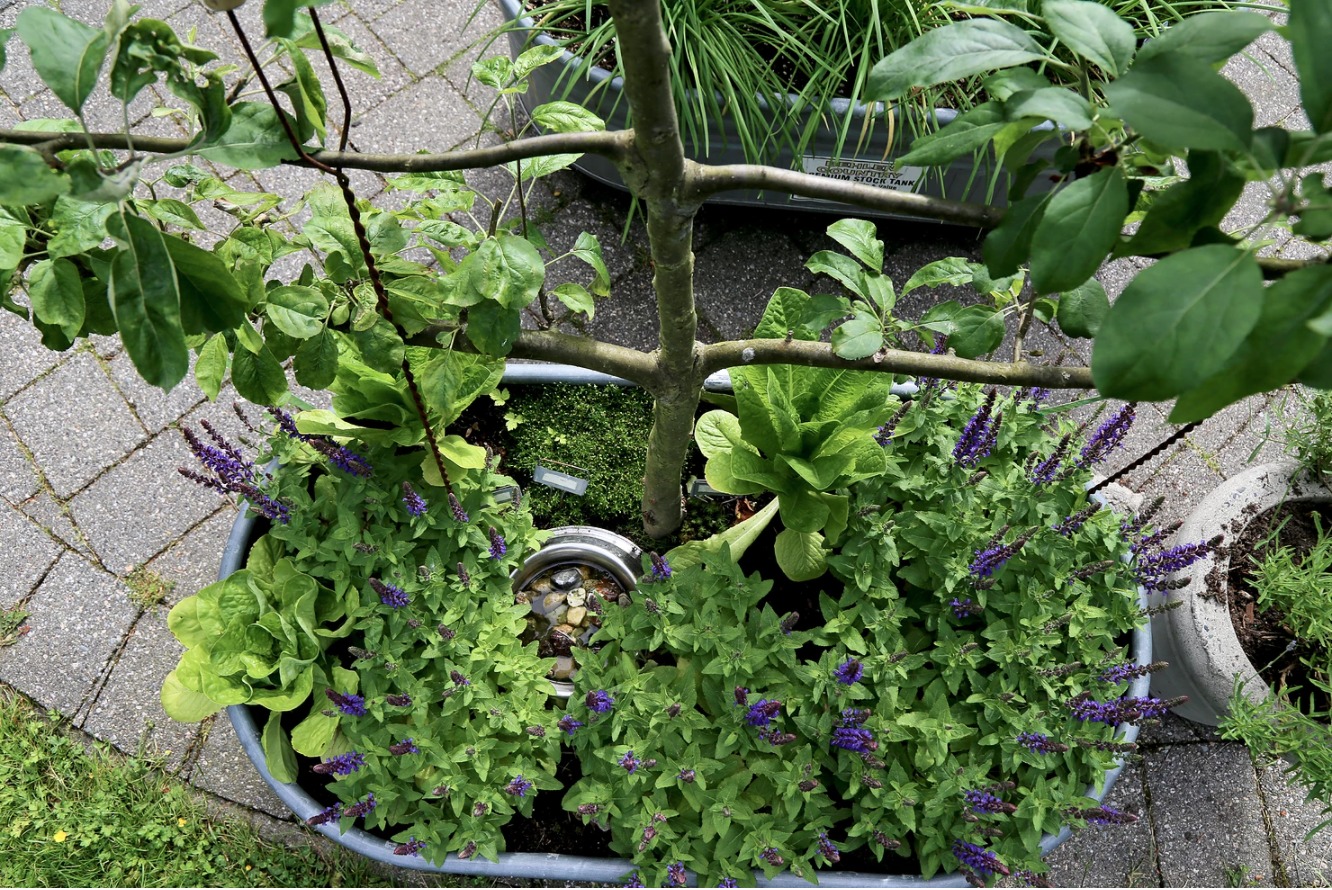Tiny Orchards & Potted Fruit Trees
During an early fall walkabout in my urban permaculture garden, I chatted with Frank Giustra about how city and suburban gardeners can enjoy high fruit yields in small spaces.
Tiny Orchards & Potted Fruit Trees
During an early fall walkabout in my urban permaculture garden, I chatted with Frank Giustra about how city and suburban gardeners can enjoy high fruit yields in small spaces.

Chatting about dwarf fruit trees with Modern Farmer publisher Frank Giustra. Columnar golden sentinels ripe for picking
It is truly AMAZING how much fruit diminutive (a.k.a. dwarf, tiny) trees can produce in a small amount of space. This is great news for urban and suburban farmers, even if you are farming in pots on a balcony. There are best-practices to adopt of course, and in true urban permaculture fashion, the best of those practices follow nature’s simple logic.
I planted a tiny fruit and nut orchard of 18 trees, including two in pots, just over one year ago in our front yard, and those trees have done incredibly well. They seem content and I am very happy with how the trees fit into my garden plan, and the joy they have brought me and my family and friends.

To be clear, my fruit and nut trees are of a particular sort known as ‘dwarf’ trees. Within that category there are many options and categories ranging from miniature bush size trees to semi-dwarf trees that reach 12-15 ft in height, to the more common dwarf offering that grow no taller than 8-10 ft. Most dwarf type trees you will find available for purchase are the latter type, and their size and shape can be further managed by pruning, and controlling how and where they are planted.
Six of our trees (three golden sentinel apple, three lapins cherry) are what are known as ‘columnar’ or vertical cordon trees. Through the magic of precision pruning, these trees produce fruit vertically along and very close to the trunk, as opposed to branching dwarf trees that produce fruit horizontally along branches.
Columnar trees are the stars of small-space fruit tree farming. Imagine a picket fence made of columnar apple and cherry trees; so beautiful and productive.
In our backyard, we have one especially beautiful older espaliered apple tree, producing gala, chehalis and gravenstein apples along three sets of paired horizontal branches grafted onto a central dwarf trunk.
Espalier and cordon (columnar, but at a 45-degree angle) are two very old techniques of pruning and shaping fruit trees to grow flat against stone walls and buildings. The thermal mass of the stone collecting solar energy all day and slow-dripping it back to the fruit at night works miracles. As urban permaculture gardeners we can this logic by placing potted fruit trees in front of masonry and walls of buildings, south-facing ones being optimal of course.
Dwarf fruit trees of all kinds are perfect for smaller space gardeners, because no matter how small the trees are, the fruit size remains standard. Dwarf fruit trees tend to produce fruit sooner than standard trees, often after just two to three years, versus three times that for standard. Through a process of ‘grafting’ conventional branches (top stalk) onto specific dwarf type rootstock (below) chosen for its hardiness and growth capacity, the ultimate size of the grafted tree is minimized. The tree’s growth directions and limitations are determined by the rootstock. The shape and branching of the tree is determined in large part by us.
In my permaculture garden, in three guilds of three trees each, I planted six apple, two pear and one crabapple tree (for cross-pollinating the apples). The trees were arranged in a triangular pattern, with equal sides of approximately 24″ in length. When siting the trees, I turned them to best advantage the sun and also each other, leaving as much of the ‘central open column’ at the centre of the triangle, between the trees, clear and devoid of any branches. When I was happy with the arrangement of and within all three guilds, I planted the trees in 50/50 native soil and organic compost (to mimic composted natural leaf litter) and then removed ALL branches that crossed over each other or into the air space of that central column.
It should be noted that if your native soil is inferior, you should amend the mixture to suit. Soil test kits are widely available. Instinctively, I did not stake my trees because I wanted to encourage strong root development quickly. Admittedly, staking is recommended by orchardists, especially in unsheltered or windy areas.
Creating and maintaining a central column is key to tree health as it affords ample sunlight, and allows for drying breezes to pass through and help prevent mildew and disease. Indeed you end up with somewhat 3/4th sided trees, but in groupings they are lovely to look at, and not at all unbalanced.
If you were to plant your trees in rows versus groupings, you would want to prune away only those branches that crossed over each other within their own individual frameworks (same reasons — to keep things dry, airy and sunny)
I keep my trees pruned to below 7ft in height, as that is how high I can comfortably reach to harvest the fruit, attend to aphids and general tree health, and prune branches twice annually.
Throughout the growing season, I check all of the trees early in the morning, to make sure I notice small changes or pests that require bio-management. This is the best time of the day for me. All is quiet, the birds are waking up, the grass is dewy and soft, and that garden-grower connection is at its strongest. In the morning I see everything, including those plants and/or insects that need help establishing or restoring balance within their habitat.

To aid in establishing balance and with respect to nature’s logic, we underplanted our dwarf tree guilds with beneficial perennial companion plants. These dual-purpose plants attract pollinators to ensure fruit-set, attract predator insects to feed on aphids and other pests, deter aphids and other pests, keep the soil cool through bio-mass mulching, feed the soil biology by contributing trace minerals and/or nitrogen, and produce edible herb foliage, flowers, seeds, etc. Some underplants are thought to emit ethylene gas which helps ripen fruit.
Practical urban permaculture suggests incorporating several different beneficial plants under fruit trees, and these range from borage to tansy. Where you live, which plants or seeds are available to you, and where you trees are planted, will determine your choices. I chose tall blue flowering borage in the centre of the circular column, medium height bushy chamomile in the middle of the circle, and low flowering chive around the perimeter. I love classic symmetry in garden design (hence, UpFront & Beautiful), so the peaceful, repeating aesthetic was important to me in the front garden. In our back garden, and for potted fruit trees, perennial underplantings are more casual and wild in arrangement.

Nearby to the apples and pears, in a perpendicular arrangement, I planted another three guilds of dwarf trees — three plums, next to a solitary almond (anticipating its size in the future), next to three columnar cherry trees. The cherries did well as they were, as did the plums overall, but it is apparent that one of the plums must be moved in the spring, as it is commanding more space than I gave it. The culprit plum is a rather special tree that has five varieties of plum grated onto a single dwarf rootstock. By its nature, I suppose, it needs more space and grows more quickly than its guild companion damson and green gage plum trees. I should have expected this and will know better next time.
This first year of real fruit set, we ate and preserved a bounty of pears, apples, plums, and crabapples. The cherries were enjoyed pretty much by the birds, and the almonds require another year or two before flowering.
A lone Fuyu persimmon tree planted in a terracotta pot and underplanted with bait nasturtiums to distract aphids, is managing fruit very nicely as I write this at the end of October. Unexpectedly, almost invisibly as they do, the tree set a huge quantity of fruit early in the summer. As the season progressed and the tree self-limited its fruit production by dropping all but what it knew it could raise to maturity, the remaining fruit remained healthy and grew bigger and bigger. Today, the leaves are gone, and the fruit look beautiful, hanging on for dear life even through recent light frosts. I will leave the fruit on for some time yet as long as they remain strong and happy looking. Advice regarding off-tree (inside) or on-tree (outside) ripening is mixed, so I will watch closely every morning and decide for myself what works in my garden. If I get it wrong this year, I will know for next.
Just a few months ago in late summer, I planted two brown turkey fig trees, each flat up against a trellis upright. I had no hope of seeing fruit this year, yet both trees delivered a handful each of lovely soft figs. I will keep these fig trees pruned back hard, encouraging a low growing habit similar to the dwarf fruit trees. If the hard pruning goes well and the fig trees respond to training but still set fruit, I will apply what I learn to creating an espaliered fig hedge to separate the berry bed from the rest of the garden.
Around back, an espalier apple tree planted in an aluminum feed trough on casters, is underplanted with salvia (pollinator-friendly), chamomile (beneficial insects) and moss (insects/mulch). This small tree produces gala, chehalis and gravenstein apples in abundance, though we eat few if any of them. Now that we have the tiny orchards out front, I leave this backyard fruit, along with strawberries and some low-growing tomatoes, as bait for the squirrels and raccoons that we share our outdoor space with. The black bears that live in the surrounding forests don’t care for unripened fruit as a rule, so they don’t come around unless we leave ripened fruit or open compost as an attractant. With deference to our furry black neighbours, we are diligent about picking berries and fruit just left of ripe always, and we compost below-ground. This seems to work out just fine for us and for the wildlife. So far, so good.

This wouldn’t be an urban permaculture story if it didn’t end in abundance, so this one does. Very recently, at the suggestion of my children who wanted to make the tiny orchard fruit last as long as possible, I made a gorgeous thick and savoury fruit butter of sorts for eating and gifting. I call it ‘savoury apple butter schmear’ with shallots, Indian spices and concord raisins. Schmear because it contains so many ingredients, and also because it has so many sweet and savoury uses.

When my chef friend Robert Bartley visited last month to help Modern Farmer magazine publisher Frank Giustra and I can and oven-dry tomatoes for the Million Gardens Movement’s ‘Permaculture’ series, he brought along some beautiful Concord grapes. Like most gifts of food that I receive, those grapes set a whole chain of culinary events into motion. This time, it was oven-dried Concord raisins. Those raisins in turn inspired not just the savoury fruit butter of which they became an ingredient, but a whole program of creating and gifting unique home-made Garden to Table recipes (more later on that). Thank you Chef!
And finally, in the ultimate urban permaculture spirit of wasting nothing at all, the home-grown apple cores and peels are ruminating currently in muslin-covered glass crocks, on the kitchen table, slowly, slowly becoming apple scrap vinegar. Quite possibly, this vinegar will become an ingredient in next year’s schmear. To learn more about our Garden to Table traditions, and for recipes, visit the food gallery, which will take you to my @chefathand food page on Instagram. Very soon, I will have permaculture garden and life recipes on this site, and the @upfrontandbeautiful Instagram page will be up and running too.
Follow us
This work is licensed under a Creative Commons Attribution-NoDerivatives 4.0 International License.
Want to republish a Modern Farmer story?
We are happy for Modern Farmer stories to be shared, and encourage you to republish our articles for your audience. When doing so, we ask that you follow these guidelines:
Please credit us and our writers
For the author byline, please use “Author Name, Modern Farmer.” At the top of our stories, if on the web, please include this text and link: “This story was originally published by Modern Farmer.”
Please make sure to include a link back to either our home page or the article URL.
At the bottom of the story, please include the following text:
“Modern Farmer is a nonprofit initiative dedicated to raising awareness and catalyzing action at the intersection of food, agriculture, and society. Read more at <link>Modern Farmer</link>.”
Use our widget
We’d like to be able to track our stories, so we ask that if you republish our content, you do so using our widget (located on the left hand side of the article). The HTML code has a built-in tracker that tells us the data and domain where the story was published, as well as view counts.
Check the image requirements
It’s your responsibility to confirm you're licensed to republish images in our articles. Some images, such as those from commercial providers, don't allow their images to be republished without permission or payment. Copyright terms are generally listed in the image caption and attribution. You are welcome to omit our images or substitute with your own. Charts and interactive graphics follow the same rules.
Don’t change too much. Or, ask us first.
Articles must be republished in their entirety. It’s okay to change references to time (“today” to “yesterday”) or location (“Iowa City, IA” to “here”). But please keep everything else the same.
If you feel strongly that a more material edit needs to be made, get in touch with us at [email protected]. We’re happy to discuss it with the original author, but we must have prior approval for changes before publication.
Special cases
Extracts. You may run the first few lines or paragraphs of the article and then say: “Read the full article at Modern Farmer” with a link back to the original article.
Quotes. You may quote authors provided you include a link back to the article URL.
Translations. These require writer approval. To inquire about translation of a Modern Farmer article, contact us at [email protected]
Signed consent / copyright release forms. These are not required, provided you are following these guidelines.
Print. Articles can be republished in print under these same rules, with the exception that you do not need to include the links.
Tag us
When sharing the story on social media, please tag us using the following: - Twitter (@ModFarm) - Facebook (@ModernFarmerMedia) - Instagram (@modfarm)
Use our content respectfully
Modern Farmer is a nonprofit and as such we share our content for free and in good faith in order to reach new audiences. Respectfully,
No selling ads against our stories. It’s okay to put our stories on pages with ads.
Don’t republish our material wholesale, or automatically; you need to select stories to be republished individually.
You have no rights to sell, license, syndicate, or otherwise represent yourself as the authorized owner of our material to any third parties. This means that you cannot actively publish or submit our work for syndication to third party platforms or apps like Apple News or Google News. We understand that publishers cannot fully control when certain third parties automatically summarize or crawl content from publishers’ own sites.
Keep in touch
We want to hear from you if you love Modern Farmer content, have a collaboration idea, or anything else to share. As a nonprofit outlet, we work in service of our community and are always open to comments, feedback, and ideas. Contact us at [email protected].by Laura Marie Neubert, Modern Farmer
October 30, 2020
Modern Farmer Weekly
Solutions Hub
Innovations, ideas and inspiration. Actionable solutions for a resilient food system.
ExploreExplore other topics
Share With Us
We want to hear from Modern Farmer readers who have thoughtful commentary, actionable solutions, or helpful ideas to share.
SubmitNecessary cookies are absolutely essential for the website to function properly. This category only includes cookies that ensures basic functionalities and security features of the website. These cookies do not store any personal information.
Any cookies that may not be particularly necessary for the website to function and are used specifically to collect user personal data via analytics, ads, other embedded contents are termed as non-necessary cookies.
Lovely article! Inspired me to give fruit trees a go this year. Very informative!
Columnar trees are not developed by pruning. They are a naturally occurring genetic variant tree form. But nine is a very good precocious the smaller tree rootstock. Not the smallest and may need support as it gets bigger but if kept small should be able to support itself. Take look at a copy of the book, Grow A Little Fruit Tree
Great article and quite inspiring. I wonder if you have any thoughts on protecting fruit trees from wildlife. We have herds of deer and flocks of wild turkeys moving through all the time. In the backyard, it’s easy enough to use netting and deer fencing around plant groupings. But I can’t figure out how to do that in the front yard and not offend neighbors’ aesthetics. Thanks for any ideas!
A very interesting article. It reminds me so much of me. I experiment with all kinds of fruit trees including citrus and indeed fig. I would not prune the fig tree too much. The weather will take care of that. I do prune apple and similar trees. I imagine this article is written somewhere in Canada. We don’t get bears here in Essex, UK but we do get a lot of smaller animals like; squirrels, foxes and birds. So much so I have written a children’s story book about their antics on a small farm called “Farmer Jumery” published by… Read more »
Want to buy miniature fruit trees
I loved the article, thank you for your advice. I am looking to plant a few dwarf apple trees this fall in raised beds. I was thinking of getting a 17 inch high 42 inch around raised bed per tree. Do you think would be enough?
This is the bed https://vegogarden.com/products/17-tall-42-wide-round-metal-raised-garden-bed?pr_prod_strat=copurchase&pr_rec_pid=4804413521955&pr_ref_pid=4843196055587&pr_seq=uniform
This article is an inspiration and I look forward to hopefully engaging in dwarf orchard aggie antics in the months to come! I can taste satsumas, apples, plums and avocados in the gulf coast biom in the not too distant future.
This is interesting I have found what I yearned for many years.
I just love fruit tree farming but have got no idea, this article has opened my eyes , thank you will give it a try,
Where can I buy dwarf plum trees?